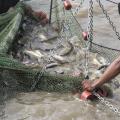Pond Construction for Catfish Farming
Proper design and construction of ponds is critical to the success of a commercial catfish operation. Well-designed ponds, constructed on soil with a proper clay content and adequate water supply, have a useful life of at least 10 years.
Pond Types
Three types of ponds are used in catfish farming.
- The first, called embankment or levee ponds, is the most common type of pond used in channel catfish farming. Embankment ponds are the preferred type for large-scale catfish farming because they can be built in large contiguous tracts, which aids in pond management. Embankment ponds are built on flat land by removing soil from the area that will be the pond bottom and using that soil to form levees or embankments around the pond perimeter.
- The second type, watershed ponds, are built in hilly areas by damming a small stream. In the long term, the major source of water is runoff from the drainage basin above the dam, although a source of pumped water is desirable to help offset evaporation and seepage during droughts. Watershed ponds represent less than 10 percent of the total pond area devoted to channel catfish farming, but are common in some regions, such as western Alabama.
- The third pond type is a hybrid between embankment and watershed ponds. These ponds may have two or three sides consisting of embankments (actually low dams) across a relatively small drainage basin. A significant amount of water may be obtained from runoff, but because the catchment area above the pond is relatively small, a source of pumped water also must be available. Hybrid watershed-embankment ponds are built in regions with gently rolling topography, such as the Blackland Prairie of east Mississippi.
Pond Morphology
The ideal size and depth of catfish ponds has changed in recent years. Fish farmers report that smaller ponds (8 to 10 acres) are easier to manage and feed than larger ponds (18 to 25 acres). Research indicates and producers confirm that deeper ponds (5 to 6 feet average depth) have a longer life expectancy and allow greater water conservation. A bottom slope of 0.2 to 0.3 inches per 100 linear feet along the long axis is recommended for adequate drainage.
Interior levees should have a minimum top width of 16 feet to allow vehicle access for management purposes even in wet conditions. Main access levees should have a minimum top width of 20 feet (preferably 25 feet) to accommodate fixed equipment such as wells, generators, and aerators while permitting passage of feed delivery and hauling trucks. These main levees should be graveled for all-weather access.
Slope is expressed as the horizontal distance (in feet) that results in a 1-foot change in height. For most soils, an outside levee slope of 3:1 is recommended. Inside slope for commercial ponds typically ranges from 3:1 to 4:1.
A single 10-inch diameter drain of heavy gauge, coated metal or PVC pie is adequate to maintain water level and drain a commercial pond. The drain should extend into the pond and past the outside levee toe by at least 5 feet. A perimeter drainage system should be constructed to receive effluents and to prevent water from standing outside levees.
MSU Publications & Information
- Research Shows Promise of Deeper Catfish Ponds
MAFES Research Highlights Fall 2003 - Catfish Budgets and Tools
MSU Department of Agricultural Economics - Costs and Returns of Catfish Pond Production in the Mississippi Black Belt Area
Technical Bulletin 226 - Search Extension Catfish/Aquaculture Publication
Other Catfish Information
- Site Selection of Levee-Type Fish Production Ponds
SRAC Fact Sheet No. 100 - Construction of Levee Ponds for Commercial Catfish Production
SRAC Fact Sheet No. 101 - Watershed Fish Production Ponds: Guide to Site Selection and Construction
SRAC Fact Sheet No. 102 - Additional Southern Regional Aquaculture Center Fact Sheets
Publications
News
STARKVILLE, Miss.
Coastal wetland conservation and restoration projects along the Mississippi Gulf Coast and beyond are running into a distinct challenge: there often aren’t enough locally sourced native plants readily available to complete these efforts.
The Mississippi State University Extension Service is meeting this problem head-on by enlisting plant enthusiasts to grow and sell these marsh plants. The effort is organized as the Native Plant Producer Network, or NPPN, and it was started in 2023.
STARKVILLE, Miss. -- Lower feed prices are providing some relief to Mississippi’s catfish producers, but many are still facing more than their share of obstacles just to break even.




